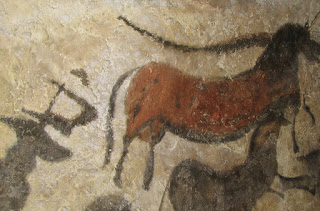- The first people to see the paintings after all that time were Marcel Ravidat, aged 18, and his friends Jacques Marsal, Georges Agnel, and Simon Coencas.
- The Lascaux Cave is actually a group of connected caves in the Vézère Valley in Aquitaine, France.
- The cave complex was opened to the public on July 14, 1948, and declared a UNESCO World Heritage Site in 1979.
- There are about 6,000 drawings in the caves, believed to be about 17,000 years old.
- Most of the paintings are of animals which would have lived in the area 17,000 years ago, but there are also drawings of humans and some abstract patterns. There are no pictures of plants or landscapes.
- The animals depicted include Horses, bulls, stags, felines, a bird, a Bear and a Rhinoceros. One of the bulls is 17 feet (5.2 m) long, the largest animal discovered so far in cave art. There is something missing, however. There are no depictions of Reindeer, which would have been a major source of food for the people who lived in the area at the time.
- The paint used was made from mineral pigments such as iron oxide, haematite, manganese and goethite, and a small amount of charcoal. The pigments were mixed with Water or animal fat and swabbed onto the wall or sprayed on through a tube. The colours used are Red, Black, Yellow, violet and Brown. Some of the pictures are carved into the stone.
- There are distinct sections to the cave complex, and the various chambers have been given names such as the Hall of the Bulls, the Lateral Passage, the Shaft of the Dead Man, the Chamber of Engravings, the Painted Gallery, and the Chamber of Felines. One chamber, called the Abside (Apse) is completely covered in paintings, even on the ceiling which is in places 2.7 metres high (almost 9 feet), suggesting the people who made the paintings knew how to make scaffolding of some kind.
- So why did those prehistoric people go to all that effort? Opinions vary. They could simply have been depictions of life and hunting. I mean, why do we have wallpaper today? Or they could have had a spiritual or religious significance. Perhaps they were drawn to bring good luck and ensure an abundant hunt. David Lewis-Williams and Jean Clottes have suggested the art is associated with rituals because it is similar to art found in southern Africa which relates to the visions people might have while trance dancing.
- The paintings are under threat due to mould and Lichen growing on the walls. Having the caves open to the public altered the composition of the air around them. People breathing, air conditioning and bright lights all took their toll, so in 1963 the caves were closed to the public. Replicas of most of the paintings have been reproduced in a nearby cave and are visited by thousands of people a year. Only scientists and preservationists can see the originals now, and sometimes even they can't. In January 2008, authorities closed the cave for three months because they found black mould growing in there. A single individual was allowed to enter the cave for 20 minutes once a week to monitor climatic conditions.
More details about my books. Follow this link if you like Superheroes, Psychics and/or quirky short stories.
I've listed the themes each novel touches on here for easy reference.
Like my author page on Facebook for news on new books and blog posts.
Check out my Writing blog


No comments:
Post a Comment